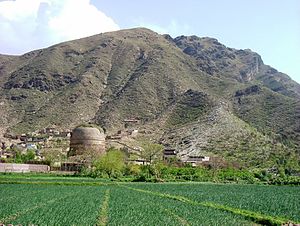Gandhāra
Jump to navigation
Jump to search


The Shingerdar stupa in Ghalegay, near Peshawar.
Gandhāra (T. sa 'dzin ས་འཛིན་; jiantuolo 健馱羅) was an ancient region comprising Kabul, Peshawar, Swat, and Taxila areas of what are now northwestern Pakistan and eastern Afghanistan. The cultural influence of "Greater Gandhara" extended across the Indus River into the Potohar Plateau of Punjab, westward into Bamyan, and northward up to the Karakoram range.
The region was a major centre for Greco-Buddhism under the Indo-Greeks and Gandharan Buddhism under later dynasties, including Indo-Scythians, Indo-Parthians and Kushans. Gandhara was also a central location for the spread of Buddhism to Central Asia and East Asia.[1]
The Seeker's Glossary of Buddhism states:
- Region in the far northwest of India (now southern Afghanistan) notable in connection with the development and evolution of the doctrines of Buddhist Mahayana and Buddhist art. Famous for its style of sculpture, which was a blend of ancient Indian modified by Graeco-Roman styles of Asia Minor. Its period was 100-300 A.D. Ancient Indian Buddhist art did not depict the figure of the Buddha but symbolized his presence. Gandhara art depicts the Buddha’s figure, the whole life history of the Buddha being given. Under Kusana kings (Kaniska) i.e., during approximately the first three centuries A.D., this area was one of a flourishing and vigorous Buddhist culture with many monastic centres of learning. During the 2nd century A.D. and after, Gandhara was an area which nourished Buddhist missionary expansion northwards and eastwards into China. The multi-storied pagoda which Emperor Kaniska built at Peshawar (Pakistan), was regarded as one of the wonders of the world at the time.[2]
Further information:
Notes
- ↑ "UW Press: Ancient Buddhist Scrolls from Gandhara". Retrieved April 2018.
- ↑ Sutra Translation Committee (1998), The Seeker's Glossary of Buddhism, Sutra Translation Committee of the United States and Canada, p. 298